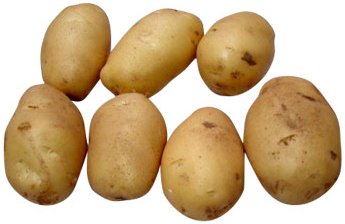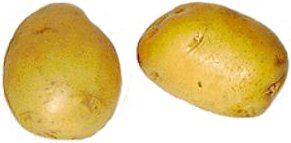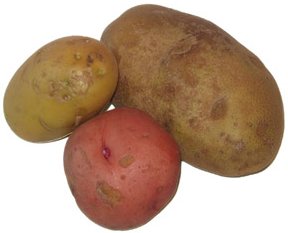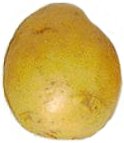

Potato

Solanum tuberosum. Solanaceae. A short-lived herbaceous perennial which is cultivated as an annual for its swollen, underground stem tubers. After flowering, the plant produces small green or purple-green berries which are poisonous. The potato originated in the Andean highlands (Peru, Colombia, Ecuador, Bolivia), where it had been cultivated by the Incas for over 2000 years before the arrival of the Spanish in the 16th century. It was first recorded in Europe in 1587 and rapidly became a staple crop in Ireland and much of Northern Europe. It was taken to North America by immigrants from Scotland and Ireland in the early 18th century. The European crop suffered from an epidemic of late blight (Phytophthora infestans) that caused widespread famine in Ireland during 1845 and 1846, when an estimated million persons died of starvation and a further million emigrated, mainly to the United States. Potato cultivation is now widely distributed throughout the world in temperate and tropical regions both for human consumption and as stock feed. There is a very large genetic variability within the species, and cultivars now exist for a wide range of environmental conditions; ancient Andean cultivars are being used to increase this range. Tuber formation proceeds better under cooler conditions; there are cultivars adapted to warmer tropical areas although the potato is a difficult crop to grow in the hot humid lowlands compared to the cooler highland areas. Temperatures in the region of 22ºC favour early growth, but during later development lower temperatues of around 18ºC are more optimal. High soil temperatures can retard stolon initiation and tuberisation, which is generally best in the range 16-20ºC, although cultivars have been selected for cultivation at higher temperatures in the tropics. Potato foliage is very susceptible to damage by frost. The standard technique for propagating potatoes is through the use of tubers, provided the health of the so-called ‘seed’ tubers can be maintained, to guarantee quality characteristics and rapid establishment of the crop, a factor which is particularly beneficial where the growing season is short. Research continues on the development of true seed for potatoes but at its present stage this produces unacceptable levels of variability in the resulting tubers. An alternative approach under investigation is the use of micro-tubers produced in vitro by tissue culture. These have the potential for combining the advantages of normal tubers with the convenience of true seed. However, although the technology may eventually be available to the gardener, at present the standard method of propagation will continue to be via traditional seed tubers. 
In temperate regions the potato can be harvested throughout the summer months and tubers can be stored to extend the season of availability throughout most of the year. It is also possible to obtain earlier harvests of immature or ‘new’ potatoes which have a superior flavour to the later crop. The potato is a versatile vegetable which can be cooked and served in a variety of ways. Potatoes are industrially processed by drying, canning and frying as crisps. If developing tubers are exposed to light they become green and poisonous and must not be eaten even after cooking. Potatoes require an open, frost-free site, preferably with a slightly acid soil (pH 5.0-6.0). The most suitable soils are deep, fertile, well-drained and moisture-retentive, although cultivation can be carried out on a wider range of soil types. They should always be grown on at least a three-year rotation to avoid the build-up of eelworm. The soil should be deeply cultivated in the autumn prior to planting, incorporating heavy dressings of farm-yard manure or compost. Potatoes have a fairly high demand for nitrogen but excessive applications, particularly to the early crop, can lead to excessive leaf production and increased risk of disease. The crop should be propagated from healthy, virus-free tubers and wherever possible the best quality, certified seed potatoes should be purchased. These should not be planted outside until the risk of frost has passed but initial growth can be started indoors by a process known as ‘sprouting’ or ‘chitting’. This is particularly useful for advancing development of the early cultivars. 
Chitting is carried out during the latter part of winter by standing tubers in shallow trays in a light position (but out of direct sunlight) in a cool but frost-free environment. The dormant buds (‘eyes’) on the surface of the tuber are concentrated at what is often referred to as its ‘rose’ end. This should be placed uppermost in the trays to allow a number of buds to develop into strong shoots about 2.5cm long prior to planting. Depending on conditions, the process of chitting will take about six weeks. Longer shoots are liable to damage during planting and it may be necessary to provide cooler, lighter conditions if early growth is too rapid. For early potatoes the number of sprouts per tuber should be restricted to two or three by rubbing off the excess at planting, thus ensuring a harvest of larger-sized new potatoes. In the case of later maincrop potatoes all shoots should be retained for higher yield. Planting can commence in early spring starting with early cultivars. The chitted tubers should be planted rose end uppermost either in drills 10-12cm deep or in individual planting holes before covering with 2-3cm of soil, taking care not to damage the developing sprouts. Recommended planting distances vary with cultivar and tuber size but the earlier ones should be planted closer together than the later maincrop. Typically, early potatoes are planted approximately 35cm apart in rows 35-45cm apart, whereas the row spacing for later cultivars should be increased to 75cm. Seed tuber sized can significantly affect final yields and tuber size and ideally seed tubers should be approximately the size of a hen’s egg. The practice of cutting large tubers in half is not recommended as is can encourage disease. Planting can be advanced by either planting under cloches or by covering with perforated clear plastic film or non-woven polypropylene ‘fleece’, all of which contribute to soil warming during early growth. An uncovered early crop can be protected from the occasional late frost by covering exposed shoots with straw or by drawing a thin layer of soil over them. 
Potatoes should be earthed up during growth to prevent the greening of those tubers produced at the soil surface. The process of earthing up also serves to kill off weed seedlings. In practice, a single operation when plants are about 20cm high is often sufficient, drawing soil to approximately 10cm depth around the stems. Very small tubers (around 10g) planted close together in bed systems tend not to produce stolons at soil level and may therefore not need earthing-up. A more time-consuming way of preventing tubers from greening and at the same time eliminating weed competition is to cover the newly planted area with black polythene anchored firmly at the edges by a covering of soil. When the leaves start to push up the plastic, slits should be cut and the developing shoots pulled through. A crop produced in this way is easily harvested following removal of the plastic. Once tubers begin to develop they should be kept well supplied with water to ensure maximum growth. Depending on growing conditions, tubers are ready to harvest 90-120 days from planting. Potatoes may be lifted as required, removing the entire crop including the smallest tubers, which may otherwise contribute to a weed and disease problem in following seasons. Potatoes required for storage should be left in the ground for a couple of weeks after the haulm has been removed to allow the skins to harden. They should be allowed to dry thoroughly before storing in a cool dark environment, when they will provide a supply until the following season. Optimum conditions for storage are between 4-10ºC with high humidity. At lower temperatures starches are converted to sugars, giving the tubers an unpleasant sweet taste. Pests include wireworm, cutworms, slugs, potato cyst and eelworm. The most important diseases in garden cultivation include gangrene, blackleg, blight (late blight), early blight, common scab, powdery scab and various virus diseases, in particular leaf roll and mosaic. A number of serious diseases require rigorous official quarantine measures if found in the UK. These are wart disease (which has a limited distribution) and ring rot and spindle tuber, which are not established in the UK. Because these diseases are easily carried over by the tubers it is important to obtain fresh ‘certified’ seed each year and not to save one’s own. For the same reason, damaged, diseased or undersized tubers should not be put on garden rubbish heaps, where they may sprout in the following season, and volunteer potatoes should also be dug up and destroyed. 
Cultivars vary in time of maturity, disease resistance, flavour and skin colour. The following are recommended in the UK. Earlies. ‘Accent’: pale cream, firm waxy flesh; excellent flavour; moderate drought resistance. ‘Arran Comet’: waxy texture; excellent flavour, especially good for salad use. ‘Arran Pilot’: late first early; white skin and flesh; firm and waxy; excellent flavour; heavy cropper; good resistance to drought and frost; some susceptibility to blight. ‘Charlotte’: very early; smooth skinned; firm, creamy yellow flesh; excellent flavour, especially good for salads. ‘Concorde’: pale yellow, firm, waxy flesh of fine flavour; good cropper; performs well on a range of soil types. ‘Dunluce’: very early; white-skin; creamy, slightly floury flesh; good flavour; also suitable for forcing in pots. ‘Epicure’: old variety; moderate yields of white skinned tubers; white, floury-textured flesh; good flavour; recovers well from frosting. ‘Estima’: second early; smooth, pale yellow skin and flesh; good cooking and keeping quality; high yielding; good drought and blight resistance. ‘Foremost’: firm white flesh of excellent flavour; good storage and moderate yields. ‘Kondor’, (‘Condor’): second early; red skin; firm, creamy yellow flesh; stores well and heavy cropping; good resistance to blight. ‘Lola’: first early; pale yellow, floury-textured flesh of good flavour; heavy cropping. ‘Marfona’: second early; pale yellow skin; creamy flesh; cooks well without discolouration; heavy crops of large tubers; good for poor, dry soils. ‘Maris Bard’: very early; white skin; creamy flesh with good cooking qualities; heavy cropper. ‘Maris Peer’: slightly dry, creamy flesh of waxy texture and good flavour; especially good for salads. ‘Nadine’: second early; smooth skin; moist, firm flesh; good cropper; also for exhibition; some resistance to potato cyst nematode. ‘Pentland Javelin’: white skin; very white, fairly waxy flesh; especially good for boiling and salads; stores well; some resistance to potato cyst nematode; good for exhibition. ‘Ratte’: second early; long tubers with firm, waxy yellow flesh; retains its excellent flavour, (similar to that of Pink Fir Apple) throughout season; excellent for boiling and salads. ‘Red Craig’s Royal’: second early; very attractive pink skin; good flavour; especially good for salad use; good cropper. ‘Ulster Prince’: not prolific but fine-flavoured white flesh; good storage; performs best on warm soils. ‘Ulster Sceptre’: among the earliest of commercially cultivated varieties; soft, waxy white flesh; rarely discolours on cooking. ‘Wilja’: second early pale yellow skin and flesh; dry waxy texture; good cooking qualities; high yielding but needs deep ridging to prevent greening. Main Crop‘Cara’: smooth white skin, pink eyes; firm flesh; stores well; heavy cropping; good for exhibition. ‘Desiree’: pink skin; pale yellow, moist, soft-textured flesh; rarely discolours on cooking; high yielding; drought-resistant; some susceptibility to common scab. ‘Kirsty’: large round tubers; white skin; soft creamy flesh; stores well. ‘King Edward’: pink-flushed skin; dry, floury texture; high quality tubers; rarely discolours; heavy cropper. ‘Maris Piper’: white skin; cramy white flesh; good cooking quality especially for frying; dry, floury texture; high yielding; some resistance to potato cyst nematode. ‘Pink Fir Apple’: very old variety; small, often knobbly tubers with pink skin; yellow waxy flesh; excellent flavour which is retained into New Year; good for boiling (with skin), and especially for salads; low yielding. ‘Pentland Dell’: soft, dry, creamy-white flesh; tends to disintegrate on cooking. ‘Pentland Squire’: early maincrop; soft, dry texture; good all-round cooker; high yielding; susceptible to hollow heart. ‘Ramano’: very attractive deep rose skin; creamy, firm-textured flesh; high yielding; good blight resistance; good for exhibition. The following are recommended in the US. Earlies. ‘Caribe’: early; large tubers with blue-purple skin; soft creamy flesh; performs well across Canada and US; high yielding; (65 days). ‘Irish Cobbler’: early; white skin and flesh; adaptable to range of US conditions and for heavy soils; some discolouration on cooking; reliable high yields; some resistance to rots in storage; (65 days). ‘Norland Russet’: netted russet skin; white flesh; good range of cooking qualities; high yielding; resistant to scab; (65 days). ‘Red Norland’: vary early; red skin; white flesh; especially good boiler without discolouration; some scab resistance; (65 days). ‘Superior’: medium early; white skinned, uniform tuber; good storage; some resistance to scab; (65 days). ‘White Rose’: early, long tubers with smooth white skin; firm, white flesh; good flavour, especially for salads; does not store well. ‘Yukon Gold’: medium-early; large tubers; pale yellow-brown skin; yellow flesh of excellent texture and flavour; stores very well; moderate yields; (65 days).  Main Crop
Main Crop
‘All Blue’: midseason; deep blue skin; firm, moist lavender blue flesh; smoky flavour; good storage; high yields; (80 days). ‘Brigus’: midseason; blue purple skin; creamy yellow flesh; especially good for baking and boiling; high yielding; some blight and wart resistance; (80 days). ‘Cherokee’: white skin and flesh; excellent flavour retained well during long storage; good resistance to scab and late blight; (90 days). ‘Chieftain’: attractive red skin; white flesh; good yields; some resistance to scab and late blight in the field; (90 days). ‘Kennebec’: mid to late season; white skin and flesh; cooks without discolouration; good cooking qualities; high yield; susceptible to scab and sunburn; (80 days). ‘Pink Pearl’: pink skin; white flesh of good flavour; vigorous; late maturing; some wart and blight resistance; (90 days). ‘Red Pontiac’: mid to late season; smooth dark red skin; some darkening on boiling; high yielding; drought tolerant; some susceptibility to scab; (80 days). ‘Ruby Crescent’: long tubers; attractive rose-pink skin; yellow, firm, waxy flesh of excellent flavour; good range of cooking qualities; heavy yields. ‘Russet Burbank’ (Netted Gem’): strongly netted, russet skin; good range of cooking qualities; widely grown throughout US; (80 days). ‘Saginaw Gold’: midseason; tan skin; yellow, waxy flesh of excellent flavour; good cooking qualities; good resistance to hollow heart and virus; (80 days). ‘Urgenta’: midseason; orange-pink skin; pale yellow flesh of excellent flavour; light fluffy texture on cooking; high yields; some resistance to drought and wart; (80 days). Late Season‘Bintje’: late maturing; yellow-brown skin; yellow waxy flesh of excellent flavour; especially good for boiling, baking; high yielding; good storage; (90 days). ‘Explorer’: thin-skinned tubers with creamy white flesh; one of the first true potato seed available to the home gardener; does not carry tuber-borne diseases; (120 days). ‘Green Mountain’: late maturing; oblong, white-skinned tuber; good flavour but tendency to discolour on cooking; heavy yields but best suited to light soils and cool growing season; (90 days). ‘McNeilly Ever bearing’: large red-skinned tubers; soft white flesh; especially good for baking; excellent storage; harvests well into autumn. ‘Russian Banana’: late maturing; yellow skin; yellow waxy flesh of excellent flavour; heavy yields; good resistance to range of diseases. ‘Yellow Finn’: late maturing; yellow-brown skin, some russetting; bright yellow, smooth-textured moist flesh; very sweet flavour; (90 days).
|
Home
Grow Nuts
Grow Herbs
Grow Fruit
Cyberian Index
If you like this website and want one of your own contact
Cyberian All information correct at
time of publication and open to updates as necessary. No part of this website,
or its vectors, may be produced in any shape or form, using any type or design
of medium, system, equipment or otherwise without the prior written consensual
notice of the Cyberian. Any breach of these requirements will result in the
appropriate action. If in doubt, e-mail contact is recommended.
Some components of this website were obtained as open-source software and are
used in the same non-profit manner on this website.